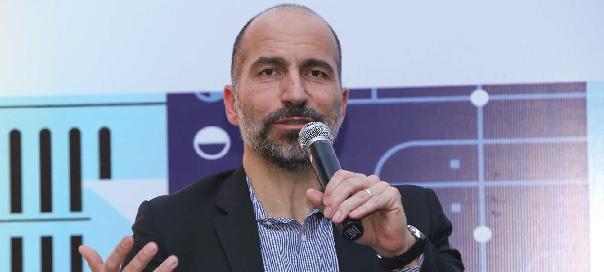Dara Khosrowshahi, CEO, Uber says that despite the company making losses, they will continue to invest ‘aggressively’ in India as he believes that their performance in the next few years is closely dependent on its growth here
He took over the company when it was in the midst of a heated controversy after his predecessor, Travis Kalanick was ousted post a series of scandals including accusations of sexual harassment. Five months into the job, Dara Khosrowshahi, CEO, Uber is on his first India visit, a market where the cab hailing company has been incurring several losses.
While speaking at an event on the future of sustainable mobility in New Delhi, Khosrowshahi clarified that despite the mounting losses, Uber will continue to invest “aggressively” in India. “We want to make the Indian market bigger for Uber. How we perform as a company five to ten years from today is very dependent on our success here in India,” he said. “We want to grow from moving people around to moving anything around; after all one of our fastest growing businesses is Uber Eats in India. We are a taxi hailing company here right now; our next step is to be a car sharing company. Cars are a highly under-utilized asset and we want to become an alternative to car ownership,” he added.
Uber lost $4.5 billion last year, a major contributor being the underperforming Indian market for the company.
The global taxi sharing giant has been losing out to Ola which is the market leader in the country’s $12 billion taxi market. Ola has managed to increase its market share from 53% in July 2017 to 56.2% in December, according to market intelligence firm, KalaGato. During the same period, Uber’s shares slipped from 42% to 39.6%. Talking about where the company is possibly going wrong Khosrowshahi said, “Ola is an excellent competitor; in fact the competition between Ola and Uber only makes our respective services better. Why Ola is very effective is because they are hyperlocal, while we have the global advantage in technology. But if we want to get to the next level in India we have to be more local and understand the Indian consumer and build our product better to attune it to their needs. That is a challenge.”
Incidentally both Ola and Uber have a common investor in Softbank. A few days ago, Khosrowshahi had called operating in developing markets “a drag on profitability” following which there were speculations of Uber merging with Ola in India, just as it had merged with the mainland ride-hailing rival, Didi Chuxing in China, after suffering major bruises. While not dismissing the possibility, Khosrowshahi said, “Five years from now we will be in the Indian market be it alone or through a merger. However, right now we are not thinking mergers and acquisitions. We are focusing more on investing in the Indian market and improving our product.”
Uber is clearly looking to up the ante in Southeast Asia. Prior to his two-day India visit where he met high-ranking Indian government officials, regulators, business partners and Uber employees, Khosrowshahi was in Japan meeting Prime Minister Shinzo Abe. Elaborating on the India business he said, “We need to continue to invest in India for the next ten years to be on the road to profitability. In fact, the profitability profile of India is getting better. We hope to increase the number of engineers in India by 3X this year and more in the coming years. We have over 3,00,000 active drivers, doing over 10 million weekly trips. Great technology companies should be more product and customer focused rather than competitor focused.” Having said that, whether Uber will be able to identify the unique needs of Indian customers and if Khosrowshahi’s visit will help Uber recover its lost market share in India, only time will tell.
@ FEEDBACK























